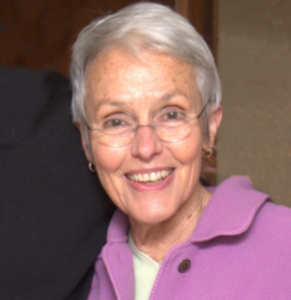
Kathleen Zuckerman is an artist by vocation and training so connecting her volunteerism with art is easy. What stands out in how her commitment to Peace House and other organizations underscores key characteristics of the artistic imagination – a keen sense of awareness, an attentiveness to detail, and an abiding curiosity. We tend to describe volunteers by focusing on their function. That’s important. Having a clear definition of expectations is essential because at a fundamental level, volunteers enable an organization to deliver its mission. For instance, how could Peace House provide “a safe space for economically marginalized women and men” and offer “a place to belong for everyone who comes through its doors” without its volunteers? At another level, however, being a volunteer is often more a matter of art than function, especially when the focus is on building and sustaining relationships. That was immediately evident in talking with Kathleen who started coming to Peace House when it was still in the old building held together by hope, patchwork repairs and, of course, the vision of Sr. Rose.
“Volunteering has always been a part of my life,” Kathleen says. She traces the roots of her commitment in part to her father’s frequent admonitions about paying attention to the needs “of the little guy,” those left behind by society and commerce. Kathleen’s mother, a lab technician, taught Kathleeen how to engage the world. Her stories about patients she met every day and the doctors with whom she worked reflected their uniqueness and individuality. In that early environment, Kathleen benefitted as well from having grandmothers who sharpened her awareness and curiosity. One taught her about nature, the other to pay attention to “what was out there.”
When Kathleen graduated in art education from the University of Minnesota, she and a friend signed on with an experimental program offered by the welfare department in New York City. They were put through an eight-week training program and soon after, Kathleen found herself with a caseload of 82 families. This experience strongly reinforced her life goals of listening and learning. Later, she got her first teaching job in a junior high school in Harlem, and her students became her teachers about the culture and complexity of that neighborhood. where her understanding of . Some years after, now married, she moved to Chicago where was hired to teach art in an all-Black high school. In addition, she began volunteering at a home for unwed mothers. After a short stint in San Francisco, she returned to Minneapolis and taught elementary art education for ten years, volunteering during that time with the Harriet Tubman organization. Then she retired. “Now what?” she remembers thinking.
That question eventually led her to Peace House. Kathleen had been volunteering at the Free Store on Franklin Avenue. The day it closed, she was driving home and passed an odd-looking building with glitter on it. It caught her eye. On the spot she decided to stop in to see what they did and whether she might help. The choices she makes about volunteering, Kathleen says, are influenced by the question, “Where will I have the greatest impact on others – and on myself?” The latter part of the question is important because the artistry in volunteering depends on a genuine spirit of mutuality. One person (the volunteer) is not the noble giver and the other (a member or client) a grateful receiver. At Peace House, where she began offering some art classes to interested members, she experienced the power of being in conversation with no particular goal in mind except to listen – and learn. She speaks eloquently of the privilege she has when she connects with a member and hears their story. A genuine curiosity in the other person is essential for such conversations to occur. This is not a matter of being nosey, but rather of opening oneself to how the life of another illumines one’s own life and, more importantly, shows the uniqueness of each person and each person’s journey. In that process of communication, the storyteller begins to appreciate how their story matters.
Paying attention in conversation involves being able to listen through the silence, Kathleen notes. When she connects with a member, she is mindful that she is not conducting an interview but waiting and watching with them as they find the words to describe the often-hardscrabble lives they live. “I return again and again to those goals rooted deep in my life of listening and learning.” What members say have an impact on her and how she sees the world. She finds that they have deepened her compassion, a central value cultivated by her Jewish and Buddhist background. “I find that I am much less judgmental generally because of conversations with members,” Kathleen says. “They open my mind and help me to realize how much we are alike.” While Kathleen cannot easily assess the impact her presence has on members, she is sustained knowing that there is inherent value in her efforts to honor people’s humanity.
In addition to relationships with members, Kathleen also believes she has been the beneficiary of the company she shares with so many selfless volunteers. She is inspired by the depth of their care and their commitment to animating the mission and vision of Peace House. As Kathleen thinks about the future of Peace House, she believes that being more purposeful in gathering volunteers to reflect on their experience and what they are learning would expand an understanding of Peace House as it is today, what it has learned from its history, and how it respond to its future amidst changing times and conditions. This, too, is how artistry becomes indispensable to a place like Peace House because it increases the versatility, freshness, and responsiveness of Peace House as it considers what lies ahead. With that creative energy in place, Kathleen believes, the practical work will follow easily.
Spotlight written by Victor Klimoski